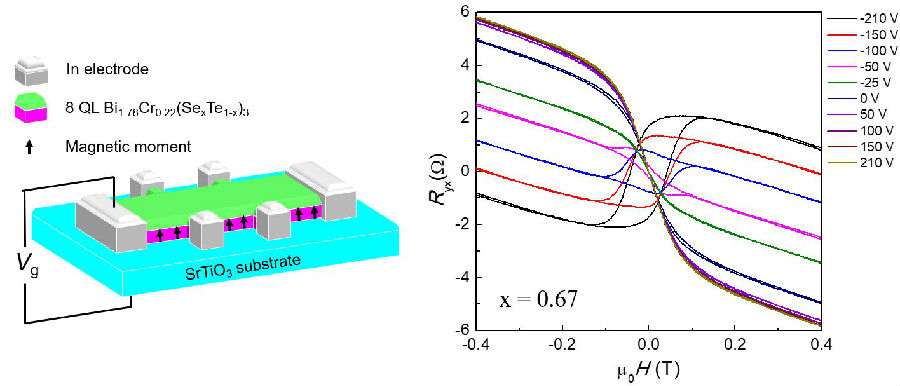Magnetic quantum phase transition in topological insulator driven by the Stark effect
The recently discovered magnetic topological insulators can host many novel physical phenomena as exemplified by the quantum anomalous Hall effect. However, there are still many unsolved problems regarding the mechanism of magnetic order and how to manipulate it experimentally. From the application point of view, it is highly desirable to control the magnetic order of a topological insulator by using an in situ gate electrode based on a field-effect transistor device, which is the foundation for the field of spintronics.
Recently, under the guidance of Prof. Yayu Wang, Prof. Ke He and Prof. Qi-Kun Xue, graduate students Zuocheng Zhang and Xiao Feng et.al from the State Key Laboratory of Low Dimensional Quantum Physics had grown a series of high quality Cr-doped Bi2(SexTe1-x)3thin films by using the state-of-art molecular beam epitaxy. In a previous report by the same group, they have demonstrated a magnetic quantum phase transition tuned by the chemical composition (Se/Te ratio) in this system. In this work, they have further fabricated the Cr-doped Bi2(SexTe1-x)3thin films into field-effect transistors (left figure below) by using the STO substrate as gate dielectric material, and investigated the evolution of anomalous Hall effect under the effect of applied gate voltage. Their experimental results show that the gate electric field has a negligible effect on the magnetic order for compositions far away from the quantum critical point. For the Se content x = 0.67, which is near the doping induced quantum critical point, the gate voltage can reversibly drive a ferromagnetic-to-paramagnetic phase transition (right figure below).

In order the understand the physical mechanism behind these experimental observations, they had collaborated with Dr. Jing Wang and Prof. Shou-Cheng Zhang in Stanford University. Their theoretical calculations show that a perpendicular electric field causes a shift in the electronic energy levels due to the quantum mechanical Stark effect. When the magnetically doped topological insulator approaches the topological quantum critical point, the inverted band structure may become topologically trivial due to the Stark effect induced energy level shift. Because band topology is closely correlated with magnetism in topological insulators, the Stark effect induced topological quantum phase transition triggers a magnetic phase transition due to the van Vleck mechanism.
Thein situelectrical control of topological order and consequently magnetic quantum phase transition reported in this work not only reveals the intimate relationship between topology and magnetism, but also paves the road for future applications in topological electronic or spintronic devices. This work, entitled “Magnetic quantum phase transition in Cr-doped Bi2(SexTe1-x)3driven by the Stark effect”, was published online on August, 7th in Nature Nanotechnology. This work was supported by the National Natural Science Foundation of China, the Ministry of Science and Technology of China and Beijing Advanced Innovation Center for Future Chip.